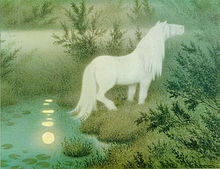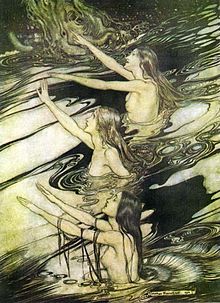- Neck (water spirit)
-
"Nix" redirects here. For other uses, see Nix (disambiguation).
- "Water sprite" redirects here. For the plant, see Ceratopteris thalictroides.
See also: Rhinemaidens and MelusineThe Neck/Nixie (German: Nix/Nixe/Nyx) are shapeshifting water spirits who usually appear in human form. The spirit has appeared in the myths and legends of all Germanic peoples in Europe.[1]
Although in recent times such creatures have usually been depicted as human in shape (albeit in many cases shapeshifting), the English Knucker is generally depicted as a wyrm or dragon, thus attesting to the survival of the other usage as any 'water-being' rather than an exclusively humanoid creature.
Their sex, bynames, and various animal-like transformations vary geographically. The German Nix and his Scandinavian counterparts are males. The German Nixe or Nixie is a female river mermaid.[1]
Contents
Names and etymology
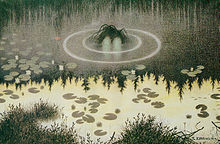 In Norway, Theodor Kittelsen's Nøkken from 1904 is equally famous.
In Norway, Theodor Kittelsen's Nøkken from 1904 is equally famous.
The names are held to derive from Common Germanic *nikwus or *nikwis(i), derived from PIE *neigw ("wash").[2] It is related to Sanskrit nḗnēkti ("wash"), Greek νίζω nízō and νίπτω níptō, and Irish nigther.[3]
The form neck appears in English and Swedish (näck or nek).[3] The Swedish form is derived from Old Swedish neker, which corresponds to Old Icelandic nykr (gen. nykrs), and nykk in Norwegian Nynorsk.[3] In Finnish, the word is näkki. In Old Danish, the form was nikke and in modern Danish and Norwegian Bokmål it is nøk(ke).[3] The Icelandic word nykur is also used for hippopotamus.[1][3]
In Middle Low German, it was called necker and in Middle Dutch nicker.[3] The Old High German form nihhus also meant "crocodile",[1][3] while the Old English nicor[1][3] could mean both a "water monster" and a "hippopotamus".[3]
Common bynames are the Swedish Strömkarlen and the Norwegian Fossegrim.[3] Since the Scandinavian version can transform himself into a horse-like kelpie, he is also called Bäckahästen (the "brook horse").
England
In the English county of Sussex, there are said to dwell "water-wyrms" called knuckers. The Word knucker is derived from the Old English nicor.[4]
English folklore contains many creatures with similarities to the Nix or Näck these Necks include Jenny Greenteeth, the Shellycoat, Peg Powler, the Bäckahästen-like Brag, and the Grindylow.
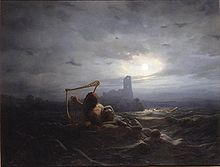 The Neck and Ægir's daughters (1850) by Nils Blommér.
The Neck and Ægir's daughters (1850) by Nils Blommér.
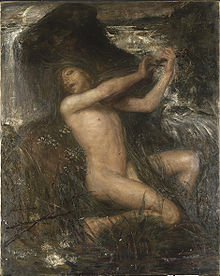 "Strömkarlen" by Ernst Josephson, 1884.
"Strömkarlen" by Ernst Josephson, 1884.
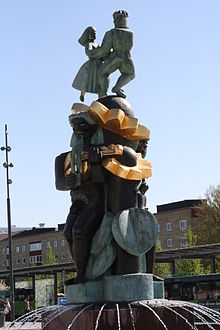 Näckens polska by Bror Hjorth.
Näckens polska by Bror Hjorth.
Näck, Nøkk
The Scandinavian näck, näkki, nøkk, nøkken, strömkarl,[5] Grim or Fosse-Grim were male water spirits who played enchanted songs on the violin, luring women and children to drown in lakes or streams. However, not all of these spirits were necessarily malevolent; in fact, many stories exist that indicate at the very least that nøkken were entirely harmless to their audience and attracted not only women and children, but men as well with their sweet songs. Stories also exist wherein the Fossegrim agreed to live with a human who had fallen in love with him, but many of these stories ended with the nøkken returning to his home, usually a nearby waterfall or brook. nøkken are said to grow despondent if they do not have free, regular contact with a water source.
If properly approached, he will teach a musician to play so adeptly "that the trees dance and waterfalls stop at his music."[6]
It is difficult to describe the actual appearance of the nix, as one of his central attributes was thought to be shapeshifting. Perhaps he did not have any true shape. He could show himself as a man playing the violin in brooks and waterfalls (though often imagined as fair and naked today, in actual folklore he was more frequently wearing more or less elegant clothing) but also could appear to be treasure or various floating objects or as an animal—most commonly in the form of a "brook horse" (see below). The modern Scandinavian names are derived from an Old Norse nykr, meaning "river horse." Thus, likely the brook horse preceded the personification of the nix as the "man in the rapids". Fossegrim and derivatives were almost always portrayed as especially beautiful young men, whose clothing (or lack thereof) varied widely from story to story.
The enthralling music of the nøkken was most dangerous to women and children, especially pregnant women and unbaptised children. He was thought to be most active during Midsummer's Night, on Christmas Eve and on Thursdays. However, these superstitions do not necessarily relate to all the versions listed here, and many if not all of them were developed after the Christianizing of the Northern countries, as were similar stories of faeries and other entities in other areas.
When malicious nøkken attempted to carry off people, they could be defeated by calling their name; this, in fact, would be the death of them.[7]
If you brought the nøkken a treat of three drops of blood, a black animal, some brännvin (Scandinavian vodka) or snus (wet snuff) dropped into the water, he would teach you his enchanting form of music.
The nøkken was also an omen for drowning accidents. He would scream at a particular spot in a lake or river, in a way reminiscent of the loon, and on that spot a fatality would later take place.
In the later Romantic folklore and folklore-inspired stories of the 19th century, the nøkken sings about his loneliness and his longing for salvation, which he purportedly never shall receive, as he is not "a child of God." In a poem by Swedish poet E. J. Stagnelius, a little boy pities the fate of the nøkken, and so saves his own life. In the poem, arguably Stagnelius' most famous, the boy says that the Näck will never be a "child of God" which brings "tears to his face" as he "never plays again in the silvery brook."
In Scandinavia, water lilies are called "nix roses" (näckrosor/nøkkeroser). A tale from the forest of Tiveden relates of how the forest had its unique red water lilies through the intervention of the nøkken:
- At the lake of Fagertärn, there was once a poor fisherman who had a beautiful daughter. The small lake gave little fish and the fisherman had difficulties providing for his little family. One day, as the fisherman was fishing in his little dugout of oak, he met the Nøkken, who offered him great catches of fish on the condition that the fisherman gave him his beautiful daughter the day she was eighteen years old. The desperate fisherman agreed and promised the Nøkken his daughter. The day the girl was eighteen she went down to the shore to meet the Nøkken. The Nøkken gladly asked her to walk down to his watery abode, but the girl took forth a knife and said that he would never have her alive, then stuck the knife into her heart and fell down into the lake, dead. Then, her blood coloured the water lilies red, and from that day the water lilies of some of the lake's forests are red (Karlsson 1970:86).
Bäckahäst, bækhest
Bäckahästen or bækhesten (translated as the brook horse) is a mythological horse in Scandinavian folklore. It has a close parallel in the Scottish kelpie.
It was often described as a majestic white horse that would appear near rivers, particularly during foggy weather. Anyone who climbed onto its back would not be able to get off again. The horse would then jump into the river, drowning the rider. The brook horse could also be harnessed and made to plough, either because it was trying to trick a person or because the person had tricked the horse into it. The following tale is a good illustration of the brook horse:
- A long time ago, there was a girl who was not only pretty but also big and strong. She worked as a maid on a farm by Lake Hjärtasjön in southern Nerike. She was ploughing with the farm's horse on one of the fields by the lake. It was springtime and beautiful weather. The birds chirped and the wagtails flitted in the tracks of the girl and the horse in order to pick worms. All of a sudden, a horse appeared out of the lake. It was big and beautiful, bright in colour and with large spots on the sides. The horse had a beautiful mane which fluttered in the wind and a tail that trailed on the ground. The horse pranced for the girl to show her how beautiful he was. The girl, however, knew that it was the brook horse and ignored it. Then the brook horse came closer and closer and finally he was so close that he could bite the farm horse in the mane. The girl hit the brook horse with the bridle and cried: "Disappear you scoundrel, or you'll have to plough so you'll never forget it." As soon as she had said this, the brook horse had changed places with the farm horse, and the brook horse started ploughing the field with such speed that soil and stones whirled in its wake, and the girl hung like a mitten from the plough. Faster than the cock crows seven times, the ploughing was finished and the brook horse headed for the lake, dragging both the plough and the girl. But the girl had a piece of steel in her pocket, and she made the sign of the cross. Immediately she fell down on the ground, and she saw the brook horse disappear into the lake with the plough. She heard a frustrated neighing when the brook horse understood that his trick had failed. Until this day, a deep track can be seen in the field. (Hellström 1985:16)
Germany
The German Nix and Nixe (and Nixie) are types of river merman and mermaid who may lure men to drown, like the Scandinavian type, akin to the Celtic Melusine and similar to the Greek Siren. The German epic Nibelungenlied mentions the Nix in connection with the Danube, as early as 1180 to 1210.
Nixes in folklore became water sprites[8] who try to lure people into the water. The males can assume many different shapes, including that of a human, fish, and snake. The females are beautiful women with the tail of a fish. When they are in human forms, they can be recognised by the wet hem of their clothes. The Nixes are portrayed as malicious in some stories but harmless and friendly in others.
By the 19th century Jacob Grimm mentions the Nixie to be among the "water-sprites" who love music, song and dancing, and says "Like the sirens, the Nixie by her song draws listening youth to herself, and then into the deep."[8] According to Grimm, they can appear human but have the barest hint of animal features: the nix had "a slit ear", and the Nixie "a wet skirt". Grimm thinks these could symbolise they are "higher beings" who could shapeshift to animal form.[9]
One famous Nixe of German folklore was Lorelei. According to the legend, she sat on the rock at the Rhine which now bears her name, and lured fishermen and boatmen to the dangers of the reefs with the sound of her voice. In Switzerland there is a legend (myth) of a sea-maid or Nixe that lived in lake Zug (the lake is in the Canton of Zug).
The Yellow Fairy Book by Andrew Lang includes a story called "The Nixie of the Mill-Pond" in which a malevolent spirit that lives in a mill pond strikes a deal with the miller that she will restore his wealth in exchange for his son. This story is taken from the Tales of Grimm.
The legend of Heer Halewijn, a dangerous lord who lures women to their deaths with a magic song, may have originated with the Nix.
See also: LoreleiSee also: Wagner's RhinemaidensAlternate names (kennings) for the female German Nixe are Rhine maidens (German: Rheintöchter) and Lorelei.
In a fictional depiction, the Rhine maidens are among the protagonists in the four-part Opera Der Ring des Nibelungen by the composer Richard Wagner, based loosely on the nix of the Nibelungenlied.
The Rhine maidens Wellgunde, Woglinde, and Floßhilde (Flosshilde) belong to a group of characters living in a part of nature free from human influence. Erda and the Norns are also considered a part of this 'hidden' world.
They are first seen in the first work of the Nibelungen cycle, Das Rheingold, as guardians of the Rheingold, a treasure of gold hidden in the Rhein river. The dwarf Alberich, a Nibelung, is eager to win their favour, but they somewhat cruelly dismiss his flattery. They tell him that only one who is unable to love can win the Rheingold. Thus, Alberich curses love and steals the Rheingold. From the stolen gold he forges a ring of power. Further on in the cycle, the Rhine maidens are seen trying to regain the ring and transform it back into the harmless Rheingold. But no one, not even the supreme god Wotan, who uses the ring to pay the giants Fasolt and Fafner for building Valhalla, nor the hero Siegfried, when the maidens appear to him in the third act of Götterdämmerung, will return the ring to them. Eventually Brünnhilde returns it to them at the end of the cycle, when the fires of her funeral pyre cleanse the ring of its curse.
Descendents of German immigrants to Pennsylvania sometimes refer to a mischievous child as being "nixie."
See also
- Huldra
- Kappa
- Kelpie
- Lamiak
- List of fictional humanoid species
- Nāga
- Naiad
- Näkki
- Nymph
- Rhinemaidens
- Rusalka and Vodyanoy in Slavic mythology
- Siren
Book sources
- Grimm, Jacob (1835). Deutsche Mythologie (German Mythology); From English released version Grimm's Teutonic Mythology (1888); Available online by Northvegr © 2004-2007: Chapter 17, page 11; Chapter 33, page 2. File retrieved 4 June 2007.
- Hellström, AnneMarie. (1985). Jag vill så gärna berätta.... ISBN 91-7908-002-2
- Karlsson, S. (1970). I Tiveden, Reflex, Mariestad.
Notes and references
- ^ a b c d e The article Näcken, tome 20, p. 317, in Nordisk familjebok (1914)
- ^ Köbler, Gerhard: Indogermanisches Wörterbuch.
- ^ a b c d e f g h i j Svensk etymologisk ordbok, by Elof Hellquist (1922) Lund, C. W. K. Gleerups förlag Berlingska boktryckeriet. p. 532.
- ^ Dragons & Serpents In Sussex
- ^ Or strömkarl (singular), per Grimm 1835:17:11.
- ^ http://www.sacred-texts.com/neu/celt/tfm/tfm056.htm
- ^ Francis James Child, The English and Scottish Popular Ballads, v 1, p 95-6, Dover Publications, New York 1965.
- ^ a b Grimm 1835:17:11.
- ^ Grimm 1835:33:2.
External links
- The Watersprite, an amateur translation (no rhyme, no meter) of Stagnelius's poem.
- Manxnotebook
- Sacred-Texts.com
- Scandinavian Folklore
This article incorporates text from the public domain 1907 edition of The Nuttall Encyclopædia.
Categories:- Germanic legendary creatures
- Scandinavian folklore
- Shapeshifting
- Medieval literature
- Mermaids
- English folklore
- Water spirits
- Scandinavian legendary creatures
- English legendary creatures
- German legendary creatures
Wikimedia Foundation. 2010.


